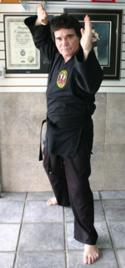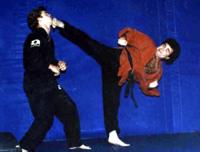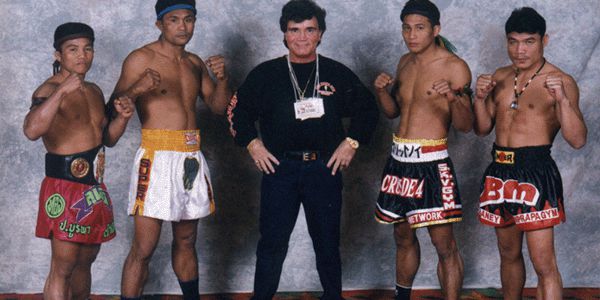Although all martial arts employ a variety of kicking techniques, undoubtedly the most widely recognized kicking styles are that of Thailand’s, “ Muay Thai” and Korea’s “Tae Kwon Do.” To the untrained eye these two styles may be as different as night and day, but according to martial arts master Bob Chaney, they have more in common than most people might think.
“Both styles believe that they are the best kicking styles in the world…and they are,” says Master Bob Chaney. “There are tremendous parallels between the two styles but there are certain differences, and I believe the effective edge goes to Muay Thai.”
Atesting to Chaney’s skill in both arts, Tae Kwon Do founder, General Choi, promoted him and Chuck Norris to 8th degree Grand Master status in April of 2000.
 As a Tae Kwon Do fighter, Chaney was once one of the nations leading tournament competitors. Today his dojang is second to none, teaching traditional Tae Kwon Do. He also is considered one of the world’s leading trainers and teachers of Muay Thai. To keep his skill’s razor sharp, Master Chaney travels monthly to Bangkok Thailand where he continues to promote and train in Muay Thai.
As a Tae Kwon Do fighter, Chaney was once one of the nations leading tournament competitors. Today his dojang is second to none, teaching traditional Tae Kwon Do. He also is considered one of the world’s leading trainers and teachers of Muay Thai. To keep his skill’s razor sharp, Master Chaney travels monthly to Bangkok Thailand where he continues to promote and train in Muay Thai.
At Master Chaney’s schools in California he teaches both Muay Thai kickboxing and traditional Tae Kwon Do. Although each style is taught independently, he sometimes blends them together. When someone from another Korean or traditional system comes in to learn Muay Thai, Master Chaney notices that they have a problem adjusting to the different style of kicking as practiced in Muay Thai.
“It’s almost better if a student doesn’t have any experience in kicking when they start training in Muay Thai,” says Master Chaney. “In Tae Kwon Do, students utilize the knee action and concentrate on ‘popping’ the leg below the knee, but in Muay Thai you drive the kick through with the hip. The execution of a Muay Thai kick requires an entirely different type of body movement and follow through than that of a Tae Kwon Do or traditional karate kick. Conversely the same is true if you try to teach a Muay Thai student how to do a ‘snap’ kick they think it’s the strangest thing in the world.”
Even with the differences in execution, Master Chaney says that both styles have their similarities.
 “Let’s take a high kick for example,” says Master Chaney. “People associate Tae Kwon Do with high kicks and Muay Thai with low kicks, but in reality Muay Thai high kicks are very similar to those used in Tae Kwon Do. Because Muay Thai is a full contact sport you’re not snapping the leg quite as much as you would if you were doing a Tae Kwon Do kick in a point tournament.”
“Let’s take a high kick for example,” says Master Chaney. “People associate Tae Kwon Do with high kicks and Muay Thai with low kicks, but in reality Muay Thai high kicks are very similar to those used in Tae Kwon Do. Because Muay Thai is a full contact sport you’re not snapping the leg quite as much as you would if you were doing a Tae Kwon Do kick in a point tournament.”
Master Chaney went on to explain that when a Muay Thai kick is aimed at the head, the foot rises above the knee and the hips rotate over, subsequently the attack is focused down through the target utilizing the effects of gravity.
“If the target was air, you would come down toward the ground and past your balance point (which is your other foot) winding up in the same position where you started from,” explains Master Chaney. “ With a Tae Kwon Do kick you snap the back kick with the lower leg and return back down to the original starting position. The difference being, with a Muay Thai kick you’re going all the way through the target, spinning 360 degrees, instead of just making contact then snapping back to the point of origin.”
Master Chaney believes that this “full circle” movement not only generates more power it also gives the fighter a better defensive position if the kick misses. Another important difference between the two styles is the angle in which a Muay Thai kick will land. Instead of a wide “arching” action, which is widely, used in Tae Kwon Do and other tradition styles of karate, the Muay Thai kick targets the neck and comes down at a severe angle, much like an axe chopping a tree. It is at the moment of contact where the similarities of Muay Thai and Tae Kwon Do once again run a parallel course.
“In Muay Thai when you kick to the neck, you roll the hips over as you’re coming down on the target and you actually accelerate the knee action, very much like that of a Tae Kwon Do kick,” says Master Chaney. “But, the knee action is not as large or ‘cocked’ as much as a Tae Kwon Do kick. You cock a bit as you bend the leg up and over but when you come down on the target you snap the lower leg action at the moment of impact and drive through until the power has a diminishing return. So the Muay Thai high kick does have a knee action, similar to Tae Kwon Do, it just doesn’t ‘snap’ back like a traditional karate kick.”
While the two styles of kicking may be kissing cousins in some regards from the point of execution, the follow through of each style is totally opposite. This however has not always been the case. When Master Chaney first began his training in Tae Kwon Do the kicks had more of a downward attack motion, and less of the high snapping arch that we see a lot of today. The long time veteran fighter says this could easily be attributed to a variation in teaching styles to accommodate traditional point tournaments and sporting competitions.
“Proper Tae Kwon Do kicking, when done correctly is very similar to Muay Thai kicking,” says Master Chaney. “When I began my training in Tae Kwon Do the kicks I learned were more like the Muay Thai kicks in the respect that we turned our hip over into the attack. We seldom ‘snapped’ our kicks, and we never dropped our guard like you see many Tae Kwon Do fighters do today.”
As a Master Instructor of traditional Tae Kwon Do, the former champion has developed several unique kicking drills to ensure that his students develop the correct form from day one.
“Ironically the same exact drill I use to teach my Tae Kwon Do students to kick properly is the same one I use to teach my Muay Thai students how to kick,” explains Master Chaney. “I put them in a sparring position with their right foot against a wall which prevents them from tucking their leg. Because they can’t tuck the leg against the wall, they must accelerate their body turn. This immediately gives them 200 percent more power in their kicks from the start.”
When Master Chaney teaches his Tae Kwon Do students how to kick he uses the same drill. Again placing their kicking leg forward and foot against the wall, they must deliver the kick from point A to point B by using the body to throw the kick. Then, after a few kicks, they slowly inch their foot back until they are throwing a rear leg kick. If they begin to “float” the leg out it scrapes the wall and he moves them back against the wall until they realize that the shortest point to any target is a straight line.
“First I teach my students that an arch does not create power; the power comes from the hips, not the arch,” Master Chaney explains. “Something that travels a greater distance does not have more power simply because it travels further. A baseball coming from the moon at 100 mph will have the same impact hitting you on the head as a baseball coming from ten inches as 100 mph. The impact will be exactly the same. The trick is to beat your opponent to the punch or kick and get there with the most power. And, that’s what I am able to get my students to do by teaching them how to use their body as a power plant.”
One of the major differences between the kicking style of Muay Thai and all other kicking styles is the point of contact. In traditional karate and Tae Kwon Do the ball of the foot, the edge, the heel, and sometimes the instep is the weapon of choice, whereas the Muay Thai fighter will focus on using his shin to take out his opponent.
“Getting hit with the shin is like getting whacked with a baseball bat,” says Master Chaney. “This isn’t just a theory, it is a proven scientific fact. Look at it this way, if you hit a ball with a baseball bat you don’t want to make contact at the end of the bat because it won’t have nearly as much power as you would if you hit the ball a third of the way up the bat. The apex of the bat is one third of the way from its tip making it the most effective and powerful point of contact. Muay Thai uses this principal of physics by using the leg like a bat at the proper angle which creates an incredible force when it lands.”
The power of this kick left thousands of spectators breathless at a recent Muay Thai fight in Los Angeles, when World Muay Thai champion BM Sasisiprapa landed a perfectly executed high kick against the neck of his opponent Mexican champion Miquel Reyes. The man crumbled to the mat where he laid fighting for his life as a stunned and silent audience watched and prayed.
“BM hit Reyes with a shin kick to the neck and he went down hard,” Master Chaney recalled. “The paramedics couldn’t find any vital signs and we were afraid that he was dead.”
The injured fighter laid in the corner for more than 20 minutes as a team of paramedics hovered over him. Fortunately Reyes survived, but he will never doubt the power of a Muay Thai kick.
“Another thing to remember about kicking with the shin vrs kicking with the foot is that the foot has a lot of small bones that can easily be broken. Not to mention getting your toes busted up in the process,” Master Chaney chuckled pointing to several toes that have seen better days. “It may hurt a bit when you hit someone with your shin, but like I told BM the day after the fight, ‘you shin my be sore, but I guarantee it doesn’t hurt nearly as much as the guy’s head that you kicked.”
Another kick that is similar but different is Muay Thai’s “push-kick” known as a teep kick and Tae Kwon Do’s “front snap kick.”
“The two kicks are very similar,” says Master Chaney. “I grew up in Tae Kwon Do and have broken my toes so many times I lost count. In Tae Kwon Do or Shotokan the idea is to bring the foot up parallel to the floor and thrust it out to the target. Sure you’re suppose to hit with the ball of the foot but frequently the toes get smashed into a knee or wind up on the receiving end of an elbow block. Although this can happen with a teep kick is doesn’t happen as often because of the nature of the kick. The teep kick is more of a ‘push’ than a snap.”
The Tae Kwon Do or Japanese style front snap kick is designed to level a blow with such force that it can break ribs and or knock down or knock out an opponent. However the purpose of a Muay Thai teep kick is primarily used to keep the opponent off guard and to stop his attack. This is not to say that the teep kick doesn’t have KO power, which it certainly does have, but the goal of the Muay Thai kick is to wear down your adversary and set him up for an attack.
“While the traditional front snap kick employs a thrusting hip action a few inches before impact the Muay Thai teep kick is a blend of a push and sidekick action,” says Master Chaney. “Often it’s used as a defensive technique but can easily be turned into an offensive weapon as well.”
The blending of these two arts is something that Master Chaney has been able to accomplish and in the process has turned out some of the best fighters in the world doing both Muay Thai and traditional Tae Kwon Do.

For more information about Bob Chaney Family Martial Arts visit their listing on the Martial Arts Schools and Businesses Directory by clicking on the image on the left.



